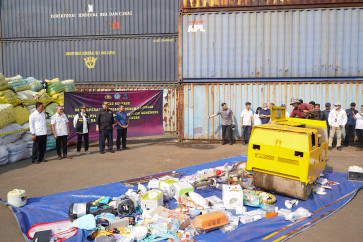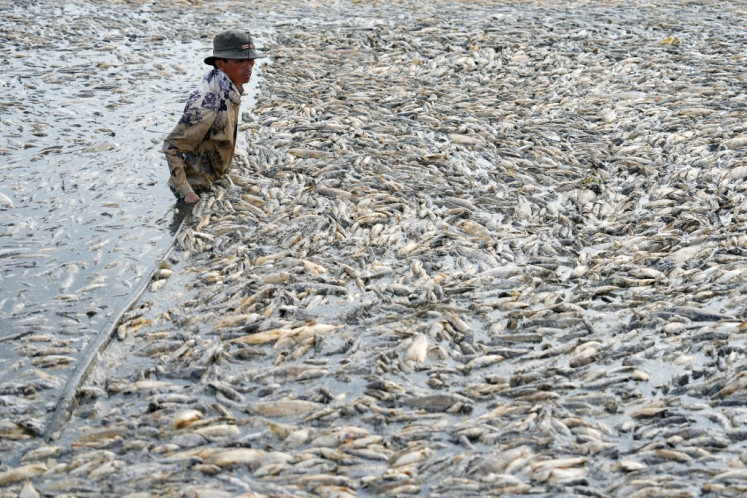Rice stock in check despite low production, high demand
Flooded: Farmers harvest rice at their inundated rice field in Terusan village, Sindang district, Indramayu regency, West Java, on Sunday
Change Size

F
looded: Farmers harvest rice at their inundated rice field in Terusan village, Sindang district, Indramayu regency, West Java, on Sunday. Hectares of rice field in the region were damaged due to the overflowing Cimanuk River. (Antara/Dedhez Anggara)
The Trade Ministry has said that the rice stock from the upcoming harvest season will last through November despite declining production and surging demand.
The ministry’s domestic trade director general, Suhanto, estimated rice production would decline by 10 percent to around 17.8 million tons, citing a report by the Indonesian Rice Millers and Entrepreneurs Association (Perpadi). Added to the current stock of 3.3 million tons, the supply would exceed national demand by 6.2 million tons, the ministry estimated.
Perpadi also recorded a threefold rise in demand recently with government agencies and private organizations buying more rice for social assistance aimed at helping those most vulnerable to the impacts of the COVID-19 outbreak.
“It means that milled rice in general has been distributed to the public either via retail markets or social assistance,” Suhanto said Tuesday in an online hearing with House of Representatives Commission VI overseeing trade and industry.
Rice farmers and food businesses are facing logistical disruptions on top of price volatility due to the large-scale social restrictions that were implemented to contain the fast-spreading coronavirus, which has infected more than 7,700 people nationwide.
The average price of rice rose by about 0.8 percent to Rp 11,950 (77 US cents) per kilogram on Wednesday from a month earlier, according to data from the government’s staple food prices tracker, the National Strategic Food Price Information Center (PIHPS).
President Joko “Jokowi” Widodo said on Tuesday that rice prices should have fallen instead, in line with the downward trend in unhusked rice prices. The average price of unhusked rice declined 4.6 percent to Rp 4,936 per kg between March and January, according to Statistics Indonesia (BPS) data in February.
As Ramadan started on Friday, the demand for rice is expected to rise even more. According to data from the Agriculture Ministry’s Food Security Agency (BKP), rice demand rose 3 percent in the days leading up to Ramadan and is expected to jump 20 percent ahead of Idul Fitri in late May.
“To ensure there is a sufficient rice stock and stable prices, the Trade Ministry has ordered Bulog [the State Logistics Agency] to distribute medium quality rice to the markets,” Suhanto said.
Meanwhile, as reported earlier, the government expected imports of staple foods to arrive in May in order to ensure not only enough supplies but also stable prices as demand is likely to surge during Ramadan and Idul Fitri..
“The government has issued import permits for garlic, chili, beef, chicken meat and sugar and they will arrive in enough volume to anticipate Idul Fitri,” Coordinating Economic Minister Airlangga Hartarto told an online briefing last Tuesday.
With Ramadan and Idul Fitri approaching amid the unfolding COVID-19 pandemic, the government was facing logistical issues caused by measures to contain the coronavirus on top of price volatility, which was already taking place even before the virus hit.
Food prices, which rose by around 6 percent year-on-year, were the primary driver of inflation between January and March, according to data released on April 1 by BPS.
The average price of garlic, for example, rose 50 percent year-on-year to Rp 44,900 (US$2.87) per kg in March, according to PIHPS. The average price of sugar similarly rose 26 percent annually to Rp 16,650 per kg last month.









